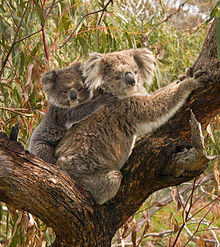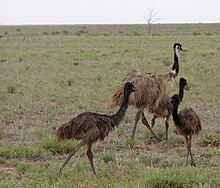
The Australasian ecoregion consists of Australia, New Zealand, New Guinea, Melanesia, and the eastern parts of Indonesia. The outer islands of Oceania make up a different region. In Indonesia, the region borders the Indomalayan region.
The region, especially Australia, is known for its unusual wildlife.
Animals
| “ | An unbeliever in everything beyond his own reason might exclaim 'Surely two distinct Creators must have been [at] work.' | ” |
—Charles Darwin's diary | ||
Mammals

There are three main categories of mammals in the world, with different reproductive cycles. Placentals, the largest group, which include humans, have a long gestation period. The only placentals that were in Australasia before human arrival are bats and rodents. Instead, Australia is home to the marsupials and the egg-laying monotremes. These are not native to New Zealand.
In marsupials, the embryo leaves the mother's uterus, and crawls into the pouch to continue growth. While marsupials are also extant in the Americas, they are incredibly diverse in Australia, occupying ecological niches of placental mammals on other continents. The common explanation for this diversity in Australia combined with the relative dominance of placental mammals elsewhere is the geographic isolation of Australia that kept most placental mammals away; the fossil record in South America shows a similar diversity of marsupials until a connection with North America was established, leading to placental mammals taking over.
Marsupials
Kangaroos are a non-taxonomic category of marsupials standing upright on strong hind legs; smaller kangaroos are called wallabies, and even smaller ones are called pademelons. The red kangaroo, Macropus rufus, is the largest marsupial, and an iconic species. Tree-kangaroos, which are found in New Guinea and northern Queensland are small kangaroo-like marsupials that lives in trees. Unlike other kangaroos, tree-kangaroos can move their hind legs independently of each other, thus allowing them to climb trees. While they are very agile in trees, they are very slow on the ground and can only hop awkwardly.
The koala, Phascolarctos cinereus, is a tree-living bear-like marsupial. The bandicoot is a small marsupial that looks similar to rats.
The largest extant carnivorous marsupial is the Tasmanian devil (Sarcophilus harrisii), which is highly endangered and, as the name suggests, only survives in the wild on the island of Tasmania. Tasmania was also previously home to a larger carnivorous marsupial known as the thylacine, also known as the Tasmanian tiger or Tasmanian wolf, though it was hunted to extinction by the 1930s. Both carnivorous marsupials formerly inhabited the Australian mainland, though they were driven to extinction with the introduction of dingoes from Asia by the Aboriginal people.

Quokkas, Setonix brachyurus, are a marsupial that looks like a small, chubby kangaroo with a cute face. In the 2010s they have become known online as the "world's happiest animal" due to their cute, cheerful appearance. Quokkas are only found in the wild in Western Australia, particularly Rottnest Island off the coast of Perth city. At Rottnest Island they are very common and willing to approach humans, and "quokka selfies" are an online craze, but it's forbidden by law to touch a quokka. In captivity, quokkas can be found at a number of zoos throughout Australia. However, there are few if any zoos outside Australia where they can be seen.
Monotremes

Monotremes are an order of mammals sometimes described as the "missing link" between mammals and reptiles. They are only found in Australasia, and include the platypus (Ornithorhynchus anatinus) and four species of echidnas.
Invasive animals
Some invasive animals in Australia are the dromedary, the dingo (a feral dog), the rabbit, and the cane toad.
The dromedary (Camelus dromedarius) is the familiar one-humped camel. Native to desert regions of North Africa, the Middle East, and western and central Asia, it has been domesticated for roughly 4,000 years, and has not naturally occurred in the wild for at least 2,000 years. However, central Australia is home to the only population of dromedaries that exhibits wild behaviour. During the 19th-century European colonisation of central Australia, camels were brought to serve as working animals. With the advent of motorised transport in the 1920s and 1930s, many of these camels were released into the wild, and their descendants have spread throughout the centre of the country. While camels have not been as damaging to the environment as some other introduced pests, they have still negatively impacted many arid and semi-arid areas, and authorities have engaged in culling programs for the last several decades. At the same time, a small but growing livestock industry has developed around the camel, with even some Aboriginal groups active in it.
The dingo (Canis lupus dingo or Canis dingo) is a feral dog that has lived in Australia for at least 3,500 years, and more likely 8,000 or more years. It is believed to have been introduced to Australia from Southeast Asia by the Aboriginal people, and also believed to have led to the extinction of the thylacine (which remained extant in Tasmania until the 1930s) on mainland Australia by out-competing them for prey. It is usually seen as a part of Australian native wildlife, as it was present before European contact. The dingo is a significant predator of domestic sheep, and less so for cattle, but also preys upon many invasive species such as rabbits, red foxes, feral goats, and feral pigs, as well as native animals. Recent studies have indicated that dingoes are less likely to seek out livestock when sufficient wild or feral prey is available. The biggest threat to dingo populations today is hybridisation with domestic dogs, which has been widespread.
The European rabbit (Oryctolagus cuniculus) was introduced to Australia with the First Fleet (the original British settlers in 1788) and quickly spread throughout the country. Rabbits have had a devastating effect on the Australian ecology through overgrazing, in turn causing severe erosion of affected areas. Efforts to control them have had mixed success.
The cane toad (Rhinella marina), the world's largest toad, is native to South America and mainland Central America, but has been introduced to many areas in the Caribbean and Pacific as a means of agricultural pest control. In the 1930s, native beetles were major pests of sugarcane plantations in northern Queensland. Because cane toads had been successfully used in pest control in other parts of the world, they were first introduced from Hawaii in 1935, with other releases in the following years. Unfortunately, they were not as effective in pest control in Australia as in other regions, and have since spread throughout the wetter areas of Queensland and the Northern Territory, and even into northern New South Wales and Western Australia. Cane toads have no natural predators in Australia, and their main defense mechanism is poison glands on their back; the tadpoles are also toxic to most predators. Most native Australian predators are vulnerable to cane toad toxin, and their numbers have greatly declined in cane toad-infested areas.
Marine life
Australian waters have a vivant population of whales, while the southern waters are also known for being a habitat for the Great White Shark. The southern waters of Australia are home to the Australian sea lion (Neophoca cinerea), while the New Zealand fur seal (Arctocephalus forsteri) inhabits the southern parts of both Australia and New Zealand.
The Great Barrier Reef is the world's largest coral reef, while the Ningaloo Reef off the northern coast of Western Australia is another very large reef largely unspoilt by tourism compared to the Great Barrier Reef. The waters off the coast of South Australia are home to the leafy sea dragon (Phycodurus eques), a seahorse which looks very much like a seaweed, thus allowing it to camouflage well and making it difficult to spot.
Birds

- See also: Birdwatching
The emu, Dromaius novaehollandiae, is the world's second-largest bird behind the ostrich, and one of the animals on Australia's coat-of-arms. Another large, flightless bird that can be found in the tropical rainforests of northern Australia is the cassowary, which though very aggressive and dangerous, is also endangered, thus making it highly unlikely that you will run into one. New Zealand's national bird is a small flightless bird known as the kiwi. Both Australia and New Zealand are home to the little penguin, also known in Australia as the fairy penguin (Eudyptula minor), the world's smallest species of penguin.
Australia is also home to several species of parrots, including the sulphur-crested cockatoo (Cacatua galerita) and the rainbow lorikeet (Trichoglossus moluccanus).
Destinations
While many species are spread across the land (or the ocean), some national parks and other places stand out for their beauty and diversity of species.
- 1 Great Barrier Reef (Off the Queensland coast). The largest biological formation in the world.
- 2 Kakadu National Park.
- 3 Watarrka National Park.
- 4 Kangaroo Island.
- 5 Lake Eyre National Park (South Australia).
- 6 Broome Bird Observatory (Broome, Western Australia). In the Broome area, there are around 300 bird species, the most famous being the migratory waders that visit Roebuck Bay over the summer and then depart for Siberia to breed during the southern hemisphere winter.
Stay safe
| “ | See, there's a reason Australia is a water-locked continent: Geography is trying to protect you. | ” |
—Cracked.com | ||
Australia is infamous for its venomous and man-eating animals, and is home to more poisonous species than any other continent. Visitors to cities are unlikely to encounter these, and most animal-inflicted injuries come from mundane pests, such as bees and wasps, as well as horse riding. In the sea, jellyfish are the most prevalent danger; while sharks and crocodiles prey on people, they are only active in a few geographic areas.
Animal collisions with kangaroos and other animals are a danger in the outback.

